Sustainable tourism indicators for Italy and the world
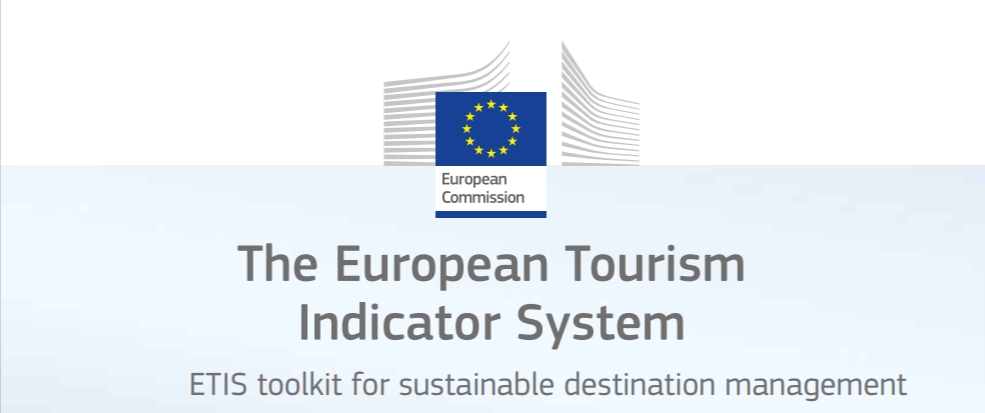
Very often we hear about sustainable tourism, much less about measures and indicators. In this article I mention some indicators and especially some case studies, some realities that have used and are using them to monitor their territory.
Among the indicators, the most important are the criteria of the Gstc, the European system of indicators for tourism (eu toolkit for sustainable destination) and the most recent global standards adopted by the UN (SF-MST) Statistical Framework for Mesuring the Sustainability of Tourism.
This is one of the most boring and difficult parts for many people: the theory. In particular the list of criteria and standards.
I assure you, however, that it is very useful to know them and have them as references, and when you understand how to use them, then it becomes the most fun part, almost (but only almost!) a game.
My task here, however, is not yet to make them a game, so let’s face them bravely.
GSTC
The Global Sustainable Tourism Council criteria are available in English for the hotel, tour operator, destination, and MICE sectors.
The criteria are divided into four sections:
- Sustainable management
- Maximising social and economic benefits to the local community and minimising negative impacts
- Maximising benefits to cultural heritage and minimising negative impacts
- Maximising benefits to the environment and minimising negative impacts.
Each section has criteria (guidelines) and indicators.
Section A (Sustainable Management) has 7 criteria and indicators.
Section B (Maximising social and economic benefits to the local community and minimising negative impacts) has 9 criteria and indicators.
Section C (Maximising benefits to cultural heritage and minimising negative impacts) has 4 criteria and indicators.
Section D (Maximising benefits to the environment and minimising negative impacts) has 3 criteria and indicators.
You can download the full list of criteria and indicators on the GSTC website
https://www.gstcouncil.org/gstc-criteria/gstc-industry-criteria/

The European Indicators
The toolkit is divided into four parts, here you will find part 3, the indicators. I invite you to download the guide if you feel it would be useful to learn more. https://ec.europa.eu/docsroom/documents/21749
Part 1 explains the concept of sustainable destination management.
Part 2 is a step-by-step guide to the implementation of the System.
Part 3 contains a summary of the main and optional indicators.
Part 4 explains how to use the destination dataset, a tool developed to capture data collected from stakeholders.
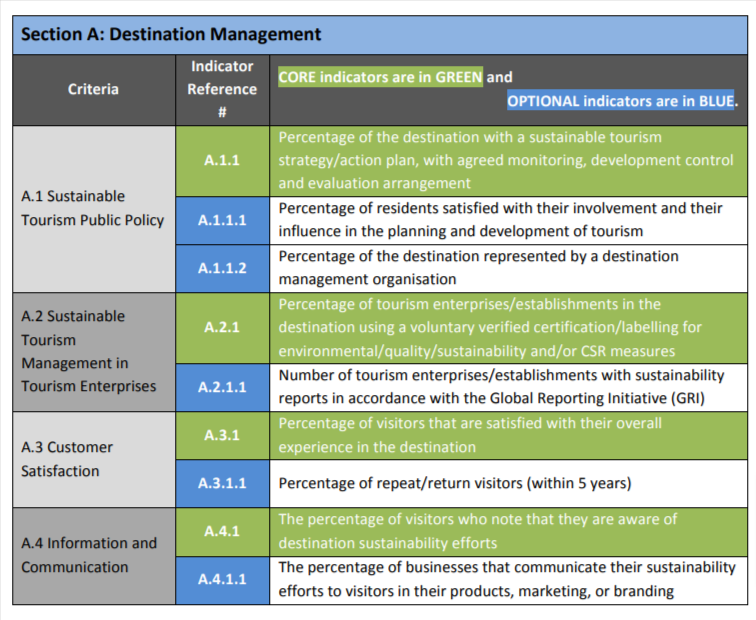
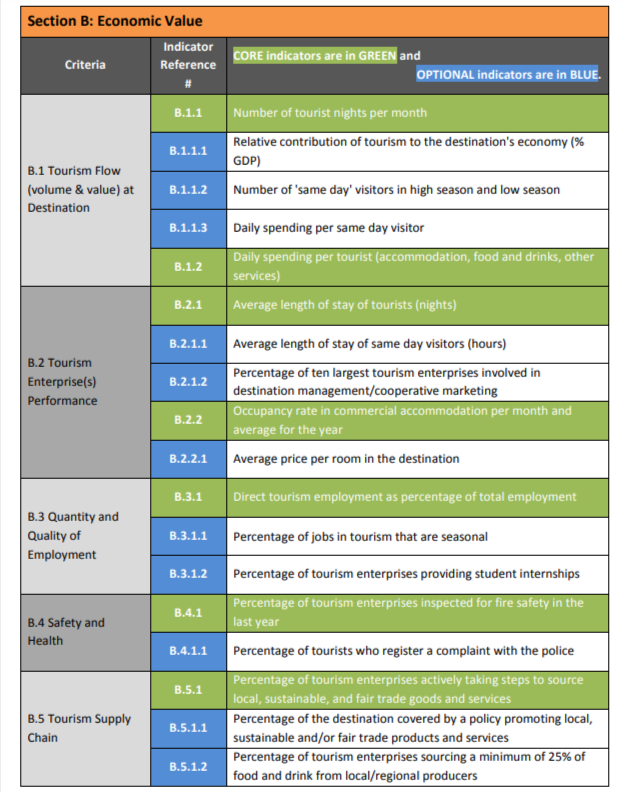
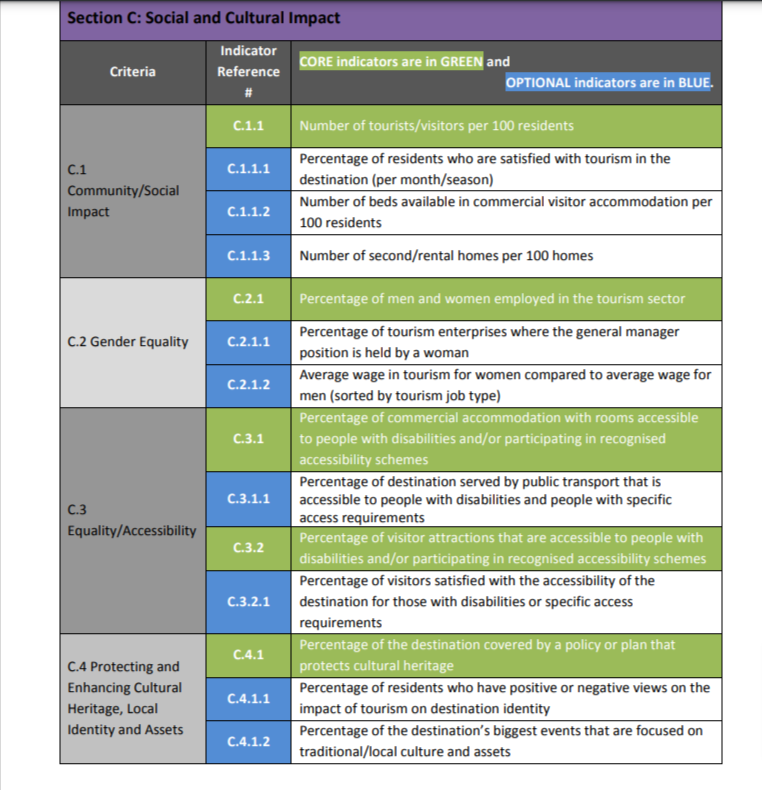
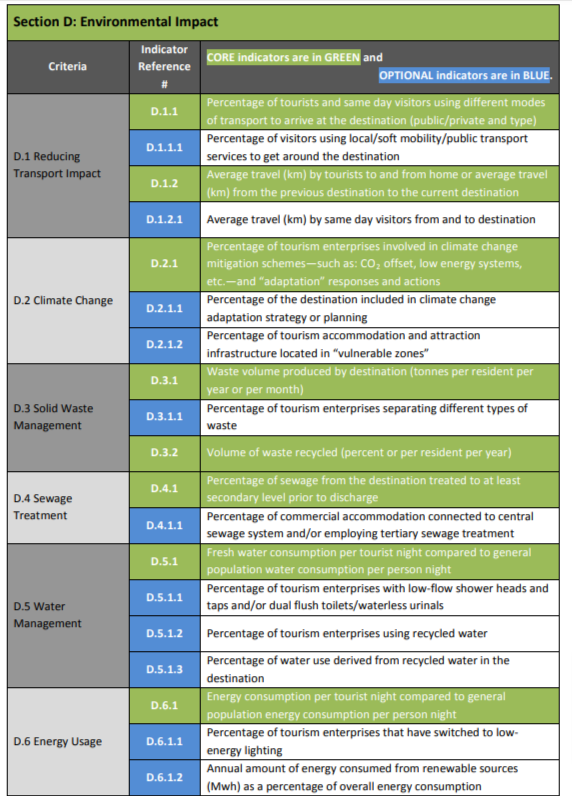
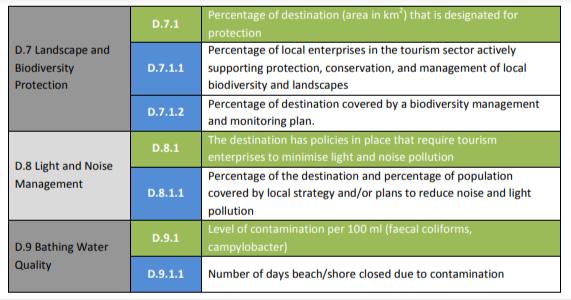
Global standards adopted by the UN (SF MST)
Dulcis in fundo: the global standards adopted by the UN (SF MST)
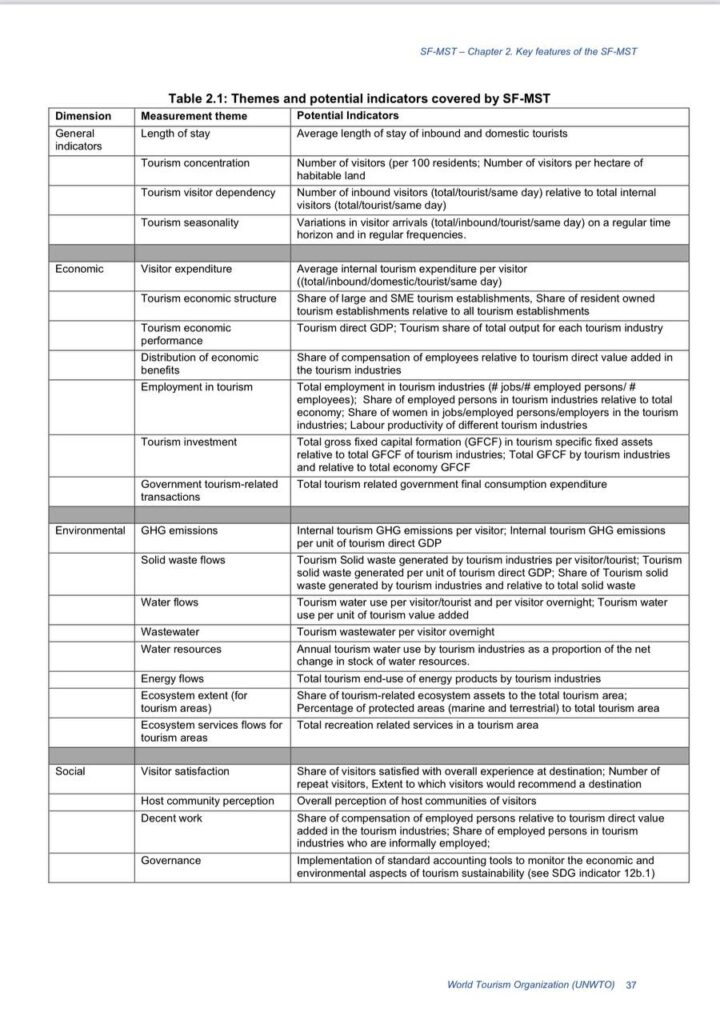
General indicators are the classic tourism indicators useful for understanding the current state of tourism in an area.
- Length of stay
- Concentration of tourism: Number of visitors (per 100 residents; or number of visitors per hectare of habitable land). This indicator is important for measuring overtourism.
- Dependence of tourism visitors
- Seasonality of tourism: Changes in visitor arrivals over a regular time horizon and with regular frequency.
Economic indicators are:
- Environmental greenhouse gas emissions: tourism greenhouse gas emissions per visitor;
- Solid waste flows: solid waste generated by the tourism sector per visitor/tourist;
- Water flows: water consumption in tourism per visitor/tourist and per overnight stay;
- Waste water: waste water generated by tourism per overnight stay
- Water resources: annual use of drinking water by the tourism sector
- Energy flows: amount of energy used by the tourism sector
- Extent of ecosystems (for tourism areas) Percentage of tourism-related ecosystems in relation to total tourism area. Percentage of protected areas (marine and terrestrial) in relation to total tourism area.
- Ecosystem service flows for tourism areas: Total recreation-related services in a tourism area.
Social indicators are:
- Social visitor satisfaction: Percentage of visitors satisfied with the overall experience in the destination.
- Perception of the host community.
- Decent work: Percentage of workers’ wages in relation to the direct added value of tourism in the tourism sector.
- Administration: Implementation of accounting tools to monitor the economic and environmental aspects of tourism sustainability.
Note the correspondence between the so-called dimensions and sections, in all criteria and indicators. There are many dimensions to be assessed, not just the environmental impact part.
Note a common feature of the indicators: they primarily provide measurement requirements.
Case studies of indicator use in Italy and Europe.
As promised, we move from theory to facts, including case studies of indicator use in Italy and Europe.
There are some interesting experiences to report e.g. Visit South Sardinia ‘VSS’ and destination management organisation (DMO) and Visit Malta. I tried to contact these organisations but unfortunately did not get any direct feedback or updates on the current status of the destinations. For Visit South Sardinia I found no update after 2016, for a prize always related to the work done between 2013 and 2014 that I describe in the next lines.
Visit Malta, on the other hand, still seems interested in working on sustainable tourism issues, I deduce this from Malta’s presentation at the GSTC conference and from the information on the site under Eco certification. There is a collaboration with GSTC to improve some aspects in the area of sustainability and to replace the national certification created in 2002 by the Maltese government. In addition, I found confirmation of the inclusion of sustainability and climate change in the 2021 – 2030 strategic plan with actions aimed at studying the phenomenon and improving the island’s response.
Visit South Sardinia

The conclusions of the study An Assessment of the Implementation of the European Tourism Indicator System for Sustainable Destinations in Italy indicate that the overall analysis of the European Tourism Indicator System (ETIS) showed that the well-known destination Visit South Sardinia (VSS) can be considered a sustainable destination.
Despite the large presence of tourism in the area, residents did not perceive tourism as an intrusion into their personal lives; on the contrary, they believe that tourism enhances the distinctiveness of the destination, strengthening its identity, culture, and local heritage.
Tourists were very satisfied with their experiences in this destination, and more than half of them returned within five years.
Each of the environmental indicators confirmed the high quality of the marine and territorial environment.
This is demonstrated by the data collected through official statistics (ISTAT and ISPRA) and questionnaires about the destination’s various realities.
The indicators used are:
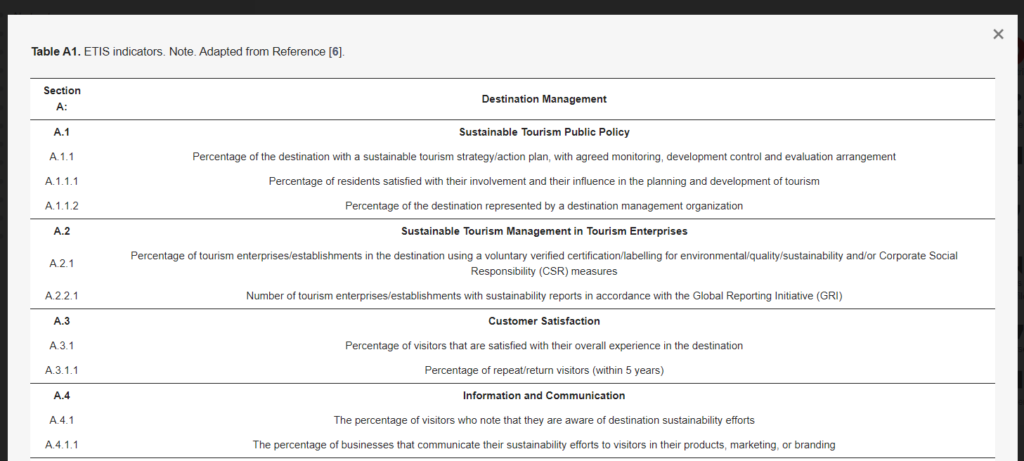
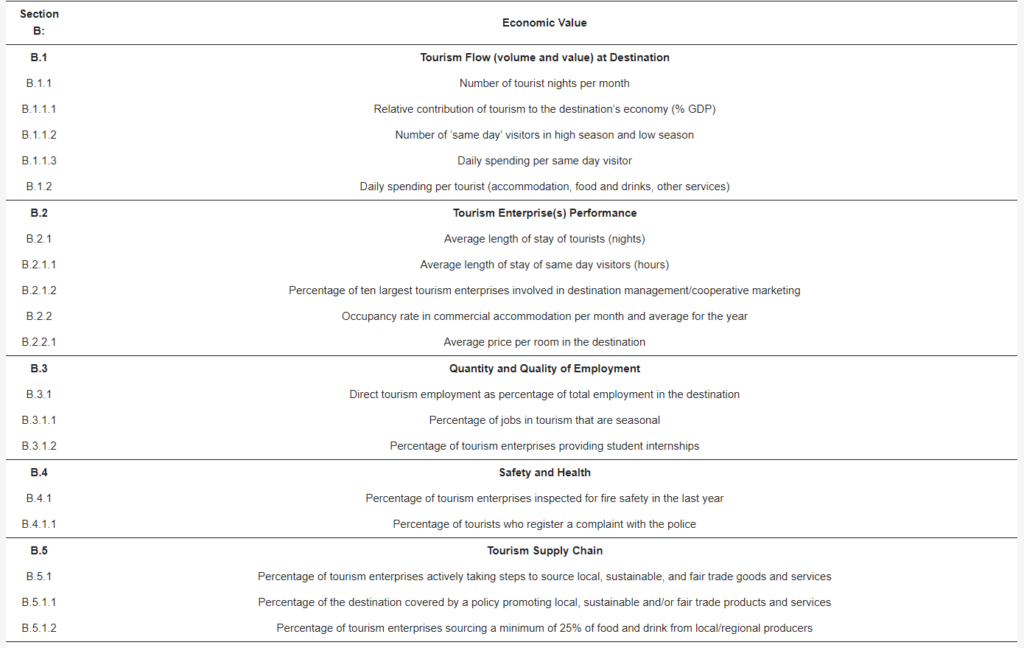
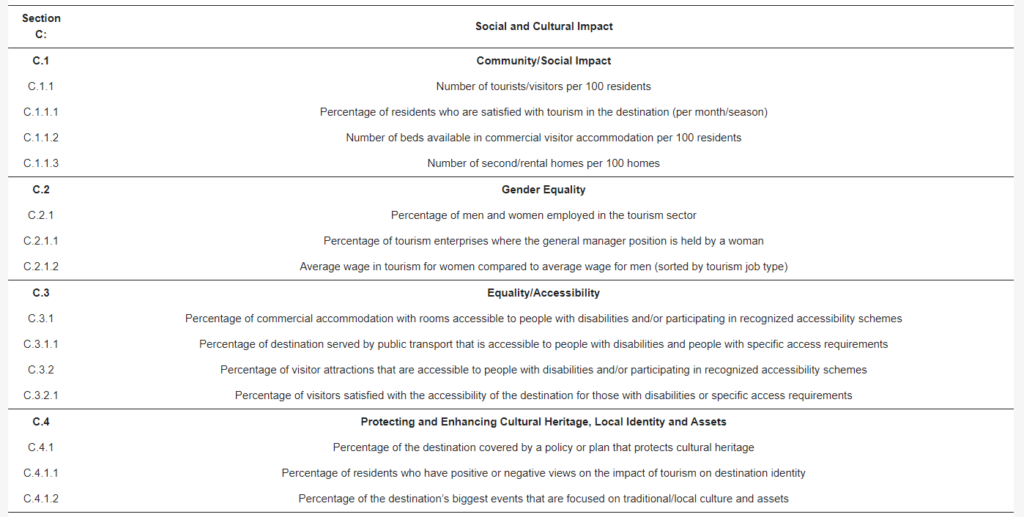
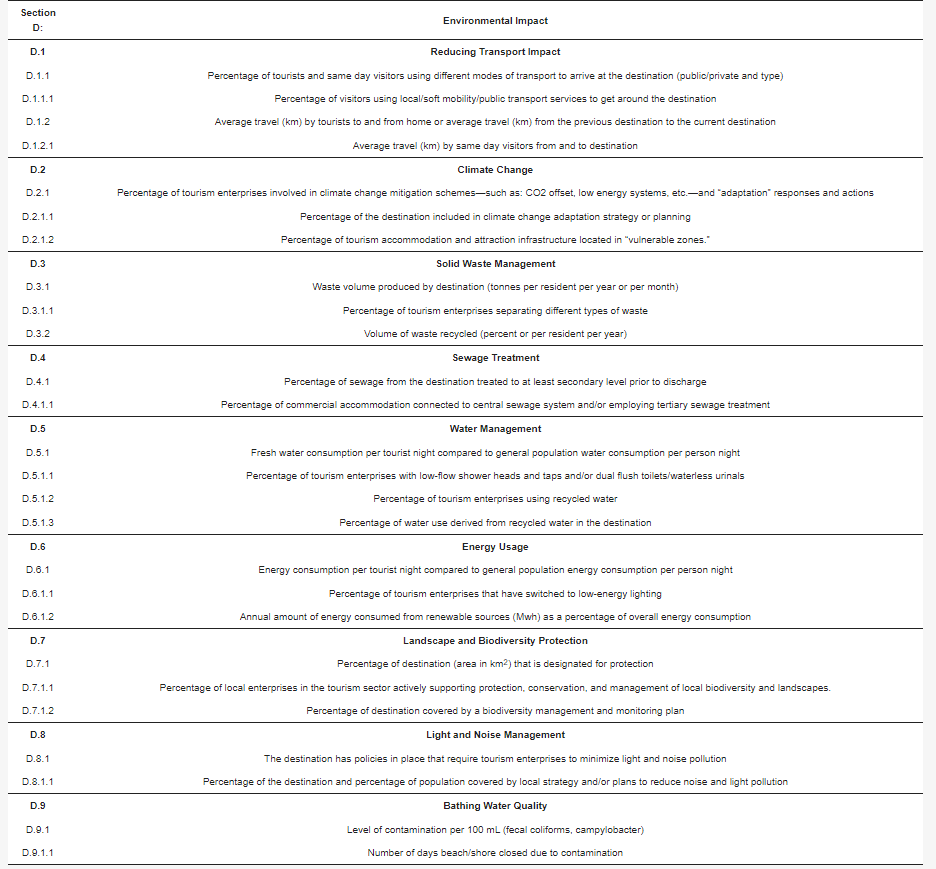
Table 2 shows the estimated values of the eight indicators for the year 2015. These values reveal the DMO’s strengths in terms of sustainability.
This DMO has one of the highest values for the tourist dimension in Italy (about 174,000 tourist overnight stays per month and an occupancy rate of 50% of the available beds, i.e. 15.1 beds per 100 residents in the area for commercial accommodation). The quality of the surrounding marine area remains remarkable.
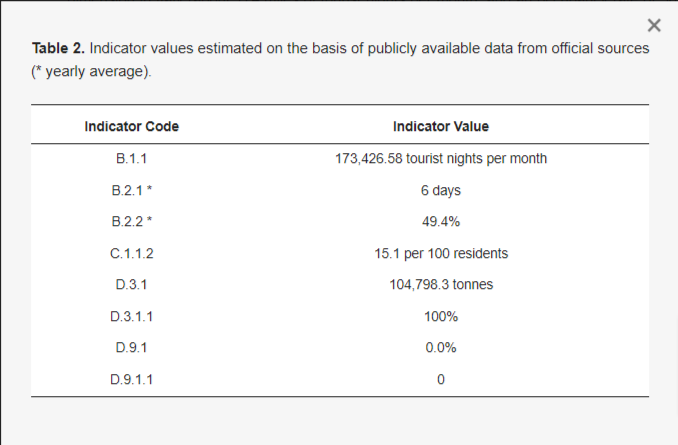
Table 3 shows the values of the indicators estimated using the data collected through the resident survey. The results indicate that seasonality influenced the level of satisfaction of VSS residents with tourism.
In particular, it was found that the respondents were very satisfied in the high season, but very dissatisfied in the low season. Furthermore, although most residents believe that tourism contributes to strengthening the distinctiveness of the VSS destination and enhancing local identity, culture and heritage, they believe that their involvement in tourism planning and development could have been broader.
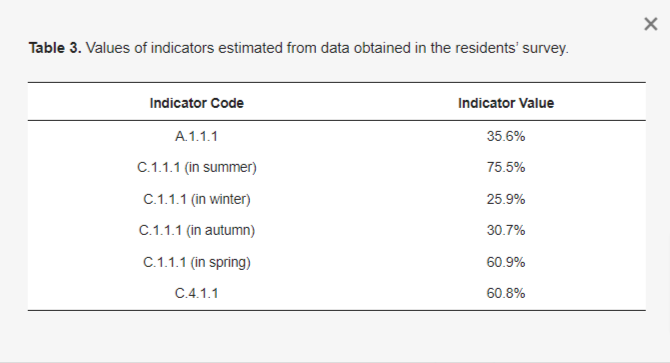
Table 4. The collected responses revealed that almost all tourists and day visitors (92.2%) are very satisfied with their overall experience in the VSS destination and more than half of the respondents (56.2%) have visited it at least once in the last five years.
Considering the lack of data on the local economic impact of tourism, the average daily expenditure of day visitors (37) and that of tourists (56) were considered two of the most critical indicators assessed.
It is noteworthy that, regarding the indicators most related to the degree of sustainable development, only 39% of the respondents were aware of the efforts to promote sustainable destinations (indicator A.4.1), and just over 50% of tourists were satisfied with the destination’s accessibility for people with disabilities or with specific access requirements (indicator C.3.2.1).
The assessment of the indicators related to the environmental dimension revealed that 44.8% of the respondents used different modes of transport to reach the destination (indicator D.1.1). Still, only 40.1% used local/soft mobility/public transport services to move within the destination site (indicator D.1.1.1). On average, tourists travelled 1,160 km to and from home (indicator D.1.2). In contrast, same-day visitors travelled 90 km to and from the destination (indicator D.1.2.1).
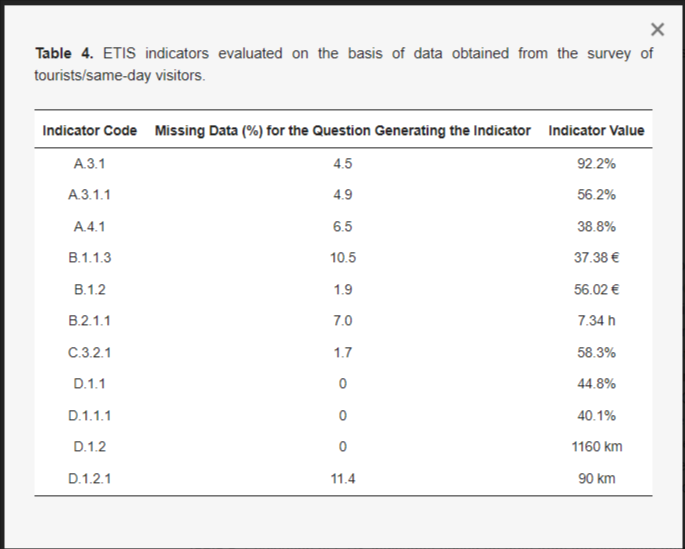
Table 5. Unfortunately, the values for the indicators related to economic activities are not present because the data available to researchers are not sufficient (errors range from 12% to 52%). The only possible thing to do in this case is to share the indicators that they should and would have used.
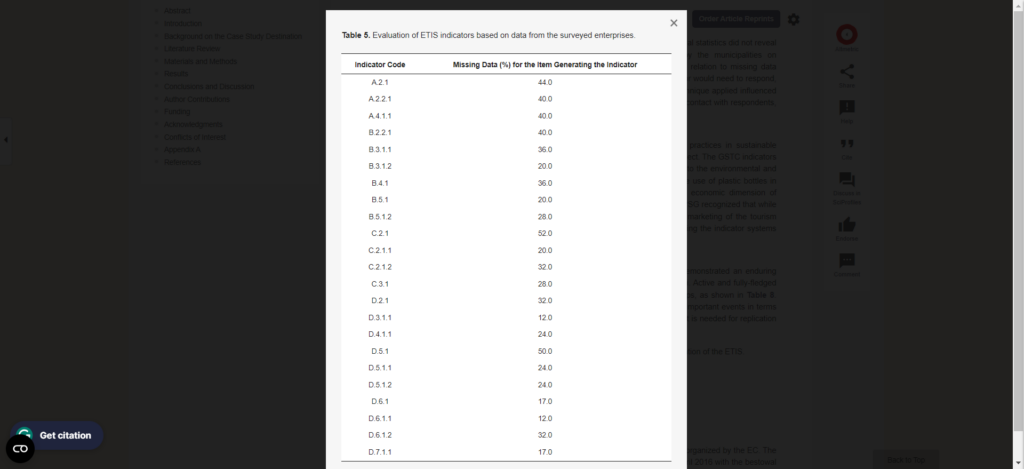
Table 6 shows the answers to the questionnaire dedicated to public bodies. Cagliari has proven to be a little less involved than other locations.
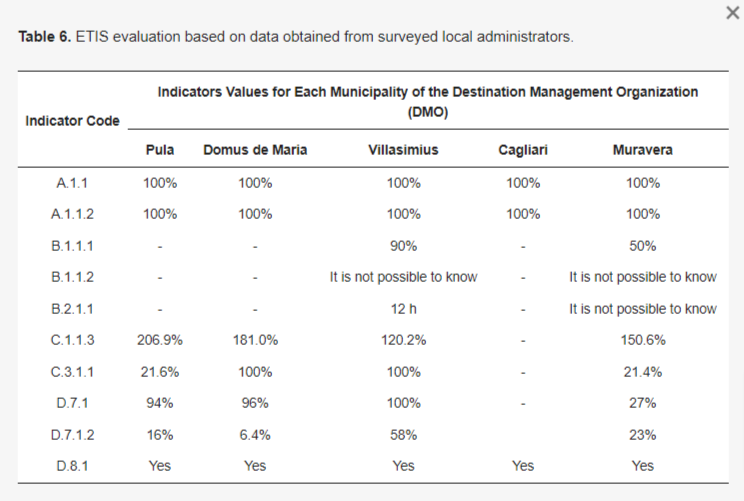
Malta
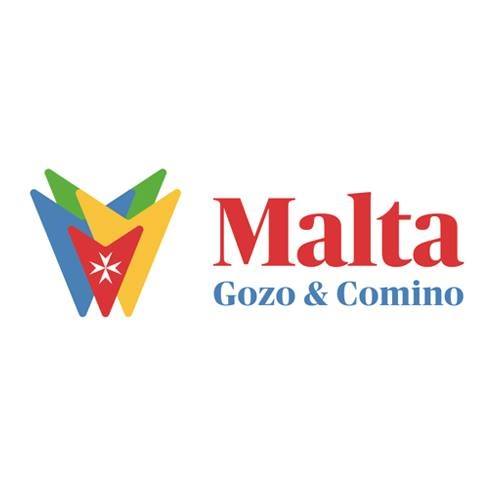
Malta has been working on its tourism development strategy for years. In 2002 the government decided to develop its own national certification scheme.
Malta tries to apply for recognition of the certification by the gstc but encounters some difficulties.
Since then and especially in recent years the Maltese government has been evaluating how to proceed to improve its strategy.
The most recent tourism strategy 2021 – 2030 addresses specific objectives related to KPIs and SDGs.
To achieve the identified objectives Malta continues a path of improvement and involves the GSTC for support and inspiration.
One of the cornerstones of the tourism strategy is the fact that Malta will not be able to build a sustainable tourism industry if its tourism priorities are driven primarily by increasing the number of beds. It is necessary to focus on what is best for the country, the economy and the host population.
The strategy is influenced by several key principles that are considered fundamental to guide the development of tourism in Malta. These principles are motivated by the internal situation and national priorities for the sector and its contribution to the wider economy.
These principles relate to the commitments and obligations that Malta has towards the European Union and other institutions, and therefore the influences are not only external but also local. Accordingly, the proposed Tourism Strategy will constitute the commitment of the tourism industry to support and fulfil Malta’s obligations arising from its different areas of activity.
Domestic
- Rebuilding Maltese tourism post-COVID19;
- Rebuilding and re-growing Airline Connectivity;
- Environmental Protection;
- Carbon-neutrality targets;
- Enhancing Visitor Satisfaction through the improved Management of Tourism through the harnessing of data and the use of modern Digitalisation technologies;
- Maximising added value both economically and socially;
- Addressing issues of sectoral overcapacities indicating a need to redirect investment opportunities;
- Planning for adequate numbers and categories of Tourism related Human Resources through the proper educational and career development channels;
- The delivery of a Quality Tourism Experience;
- Prioritising Tourism Products and Segments in line with Branding & Marketing thrust;
- Ensuring and improving Residents’ Quality of Life by monitoring and not exceeding Tolerance Levels towards Tourism;
- Tourism is a major pillar of the Maltese Economy owing to its high value added and high multiplier effects, which lead to efficiency.
International
- COVID-19 and post-COVID-19;
- Climate change;
- The UN Sustainable Development Agenda;
- The EU Green Deal;
- The EU Digital Strategy;
- The European Data Strategy;
- UN Convention on Biological Diversity.
The strategy aims to implement the Key Principles on the ground. The Key Principles enshrine sustainable values, aim to ensure operators a fair return on investments, especially in the post-COVID recovery period, and place a strong focus on education as a means to improve not only service and hospitality, but also to raise the level of quality of the service offered.
Pestel and Swot analysis
The strategy aims to implement the Key Principles on the ground. The Key Principles enshrine sustainable values, aim to ensure operators a fair return on investments, especially in the post-COVID recovery period, and strongly focus on education to improve service, hospitality, and the quality of the service offered.
PESTEL Analysis looks at the Political, Economic, Social, Technological, Environmental, and Legal factors affecting Tourism in Malta.
PESTEL analysis is often used with a SWOT analysis (Strengths, Weaknesses, Opportunities, Threats) to identify the opportunities and threats in a more structured way that ensures all possible factors are considered.
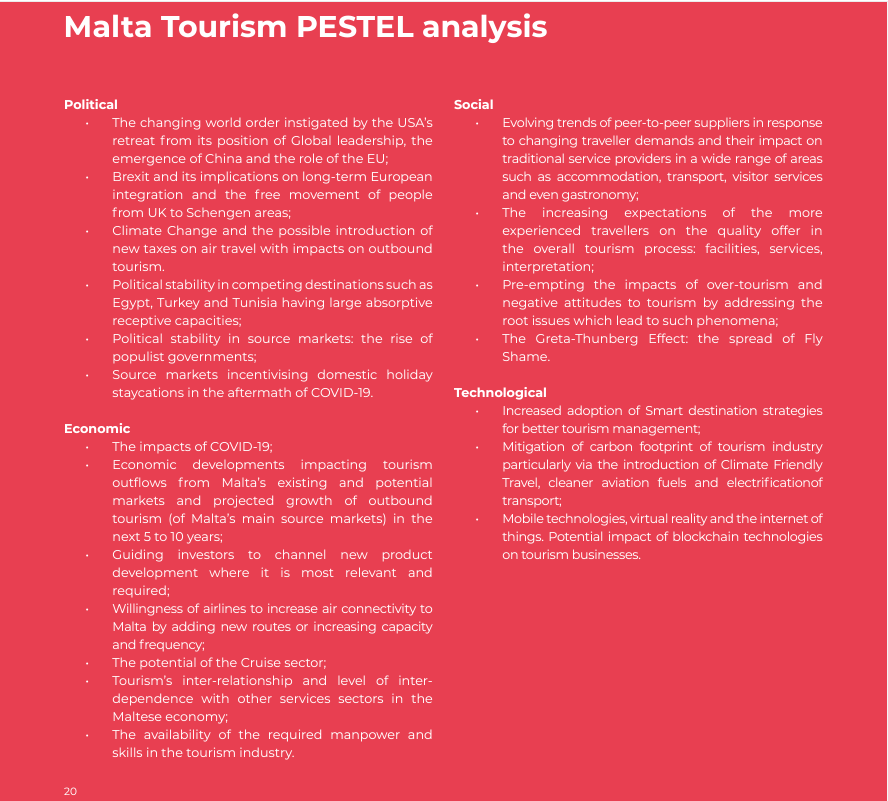
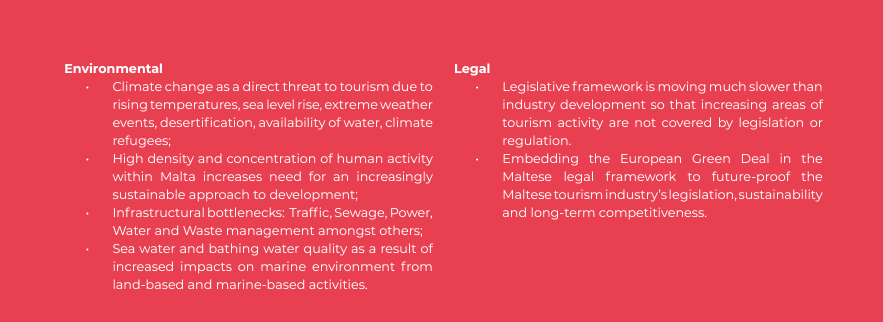
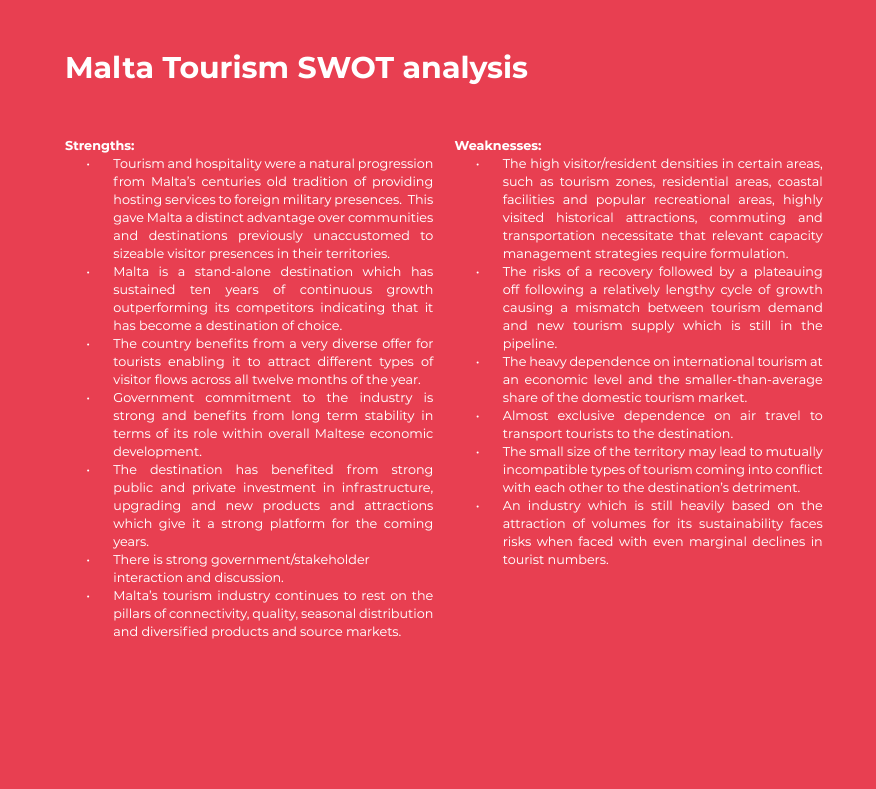
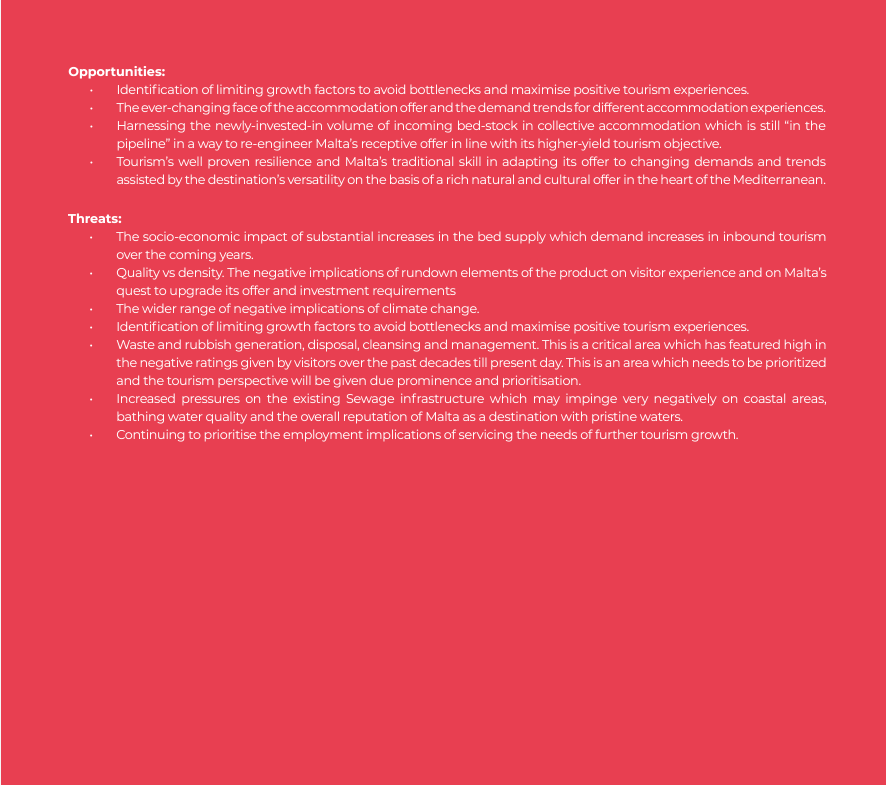
Several strategic options and alternatives have emerged for consideration following the Destination PESTEL and SWOT Analysis:
The 13 Challenges listed below represent Strategic Challenges. The term “Strategic Challenges” refers to pressures that influence the likelihood of future success. These challenges drive and affect the destination’s future competitive position relative to other providers of similar products. They are presented in order of precedence and importance as follows:
- Rebuilding the airline route network
- Enhancing the Visitor Experience
- Improving the Country’s General Appearance
- Integrating quality at all levels of the value chain
- Managing accommodation development
- Re-directing potential investment in bed stock into other key areas
- Addressing the HR dimension and supply-side requirements
- Increasing per capita spend
- Reviving sector profitability
- Recovering under sluggish conditions
- Minimising downward price spiral potential with resulting drops in rates
- Fostering cross-collaboration across various digital tourism initiatives through the consolidation and better use of data
- More robust integration of Sustainable Development Goals and the EU Green Deal.
In addition to the 13 strategic challenges indicated, the strategy presents 11 strategic objectives linked to a specific set of UN sustainable development goals and 22 individual strategies. The 22 Strategies present no less than 125 Goals and 245 Actions stemming from these Goals.
In this article, I report only the objectives and actions most relevant to increasing the integration of the SDGs and the EU Green Deal.
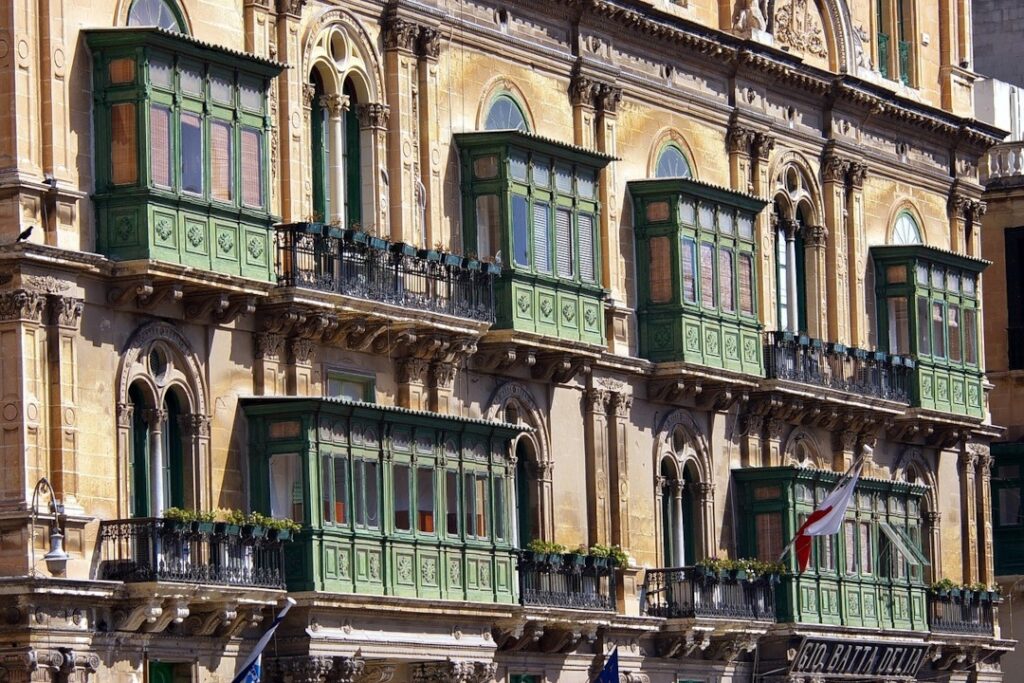
Strategy 10. To give due recognition to the detrimental effects which unchecked climate change and global warming are bound to have on the country’s tourism appeal and to engage in a national and international effort aimed at achieving Climate Friendly Travel by 2050.
Objective. To prioritise the establishment of Malta as a Climate Friendly Travel Destination through the dual actions of understanding and mitigating the impacts of Climate Change on the local territory and its tourism infrastructure and to concurrently take a leading international role in championing Climate Friendly Travel with the travel industry, academia and other stakeholders as a response to the existential threat of global warming.
Goal 1. Understand Climate Change’s impacts on Travel and Tourism. Apply the science to Malta’s realities. Quantify the scale and nature of the threat.
Action 1. Follow international literature, findings and guidelines, especially those from territories similar to Malta.
Action 2. Produce regular updates on threat levels for the different elements identified.
Goal 2. Investigate potential Climate Change impacts on Malta’s coastal amenities, infrastructure, beaches, harbour facilities, residential and accommodation plants, historic towns, water and power production/ generation, yachting and boating facilities, aquifers, natural hazard incidence and other factors. To create a Climate Change Tourism Risk Index.
Action 1. Undertake a Study on Climate change-related impacts on the elements identified in this Goal.
Action 2. Develop, produce and regularly update a Climate Change Tourism Risk Index for Malta.
Goal 3. Apply the findings emerging from Goals 1 and 2 to form the basis of actions to be undertaken to minimise risks, affect protective/preventative measures, plan alternative strategies and draft plans to create future market repositioning accompanied by the relevant product development initiatives to adjust the tourist offer to the new emerging realities.
Action 1. Produce a Tourism Climate Change Response Plan for Malta featuring a mix of proactive and mitigating measures.
Action 2. Follow international Climate Change developments and responses to better understand developments worldwide and the tweaks and adjustments necessary to adapt the tourism industry to changing situations.
Goal 4. Categories, quantify and locate which aspects of the Maltese tourism industry are most likely to be influenced by climate change.
Action 1. Generate a living document categorising, quantifying and locating Climate change-prone elements of Maltese Tourism.
Action 2. Provide annual updates to this document.
Goal 5. Source and investigate international best practices in the different fields regarding mitigation measures.
Action 1. Participate in international fora at a European and Mediterranean level.
Action 2. Engage with specialist firms and organisations to provide continuous direction in this highly technical area.
Goal 6. Follow and contribute to international fora discussing Climate Change and Travel and ensure that the small island state perspective is recognised adequately in discussions and decision making.
Action 1. Present Malta’s position and experience in decision-making structures to alert them of the impacts of decisions and directives they propose.
Goal 7. Work towards establishing Malta as a credible and effective climate-friendly travel destination through an ambitious portfolio of local and international actions.
Action 1. Undertake various actions at a local level to establish Malta as an innovator and Climate-Friendly Travel destination.
Action 2. Take a leading international role in steering a discussion, bringing together the broadest range of industry players and sectors to champion the cause of climate-friendly travel as a tangible response to Climate Change.
Strategy 11. To introduce a set of measurable climate and sustainability indicators to correctly measure tourism impacts on the environment to ensure that tourism development embraces sustainable parameters within the broadest possible range of quantifiable variables.
To measure and monitor tourism activity in the Maltese Islands in a way that follows the principles enshrined in the Sustainable Development Goals, particularly the thirteen Goals that this Strategy focuses on. To develop and produce a set of Key Performance Indicators to measure activity in terms of SDGs, which recognise the specific realities prevailing within the territory of the Maltese Islands. Apply the findings emerging from such indicators to decision-making processes.
Goal 1. Apply international best practice in terms of starting to measure a range of sustainability indicators based on inputs and experiences from similar sized regions and territories to be able to start measuring and applying such indicators within Malta’s realities.
Action 1. Utilise existing and available expertise from a number of specialised sources to devise a set of sustainability indicators for the destination.
Action 2. Convert the indicators into KPIs and devise ways of measuring and monitoring them on a regular basis.
Goal 2. Apply Climate Friendly Travel indicators to encourage destination carbon neutral initiatives covering a range of areas such as transport, tourism operations and infrastructural needs.
Action 1. Create a list of indicators for particular areas.
Action 2. Continuously monitor.
Action 3. Publish and publicise and undertake actions in response.
Goal 3. Convert Indicators into Decision making tools.
Action 1. Create systems to integrate the direction forthcoming from Indicators in Goals 1 and 2 into policy making.
Goal 4. Engage in international fora to benchmark methodologies, results and sustainability aspirations.
Action 1. Identify and participate in relevant fora.
Goal 5. Actively focus on measures aimed at furthering gender mainstreaming and empowerment in the tourism industry as fundamental components of just, equitable societies. Tourism has already been proven to provide pathways to empowerment, and the opportunity for tourism to make a positive difference in this area should be maximized through the involvement of the relevant stakeholders.
Action 1. Achieve a greater understanding of issues impacting gender mainstreaming and empowerment, generally and specifically in the tourism industry.
Action 2. Identify which areas of employment in the tourism industry need to be addressed to improve gender mainstreaming and empowerment.
Action 3. Formulate an Action Plan with clear objectives and timeframes.
Goal 6. Devise a Sustainable Tourism Charter involving wide stakeholder buyout and application. Such a Charter inspires a Code of Conduct to guide tourism operations and activities.
Action 1. Draft a Sustainable Tourism Charter for Malta to encompass the destination’s sustainable tourism aspirations.
Action 2. Attract wide stakeholder acceptance and buy-out of the Charter.
Action 3. Use the principles enshrined in the Charter to draft a Code of Conduct for the Tourism Sector.
Strategy 12. To build a strong case for the conservation and preservation of natural and man-made tangible and intangible heritage in recognition of their growing relevance and importance to the discerning tourists of today and tomorrow and to promote such heritage as an integral component of the Malta brand. To promote protected areas as models for sustainable tourism, enhancing responsible travel to natural areas, which conserves the environment and sustains the well-being of local people.
Objective. To advise, educate and familiarise the Maltese Tourism Industry with the wide spectrum of Malta’s natural and man-made tangible and intangible heritage for its stronger integration within the Maltese Tourism Offer, its promotion and presentation to tourists and its preservation and valorisation in a responsible, sensitive, and sustainable manner which protects it for future generations of residents and visitors alike.
Goal 1. Create a list of tangible Cultural/Heritage and other attractions in the Maltese Islands including their protection/preservation status.
Action 1. Commission an Inventory of Tangible Cultural/Heritage and other attractions as per Goal 1 including current standard of offer.
Action 2. Tap into existing information lying with various Ministries, Agencies and Organisations.
Goal 2. Research existing and former intangible cultural and traditional elements particular to zones or localities in terms of their relevance to enhance local character and diversify offer. To include contemporary culture as manifested through arts and entertainment.
Action 1. Extend the information sources for Goal 1 to cover intangible elements as well.
Goal 3. Tap into the extensive local knowledge of Local Councils, Voluntary Organisations and NGOs to compliment Goals 1 and 2 with further inputs and anecdotal evidence.
Action 1. Expand into the local dimension to seek specific, otherwise uncovered elements of tangible and intangible nature and compile information in a usable manner.
Goal 4. Include the Marine Dimension primarily as a distinct, additional zone relating to the territory and secondarily in terms of its specific relevance to each specific zone and locality.
Action 1. Treating the maritime dimension as a natural extension of the landmass and inventorising its natural, topographical and socio-cultural dimensions in addition to their terrestrial counterparts.
Action 2. Place more focus on the importance and relevance of Marine Reserves and strive to protect and increase marine life through a number of measures including wrecks and artificial reefs to sustain the scuba diving market.
Goal 5. Publish, Disseminate and Publicise the outcomes of this Strategy to serve as a strong motivator for the growth of a more sustainable approach to tourism development.
Ensure that the knowledge emerging from Goals 1 to 4 are properly disseminated and publicised to assist in a greater appreciation and application of these values amongst stakeholders.
Strategy 13. To secure European and National funds to push for tourism product development and improvement. To do this in liaison with other Ministries and Agencies whose remit and responsibility overlap with tourism.
Objective. The successful execution of this Strategy and its multiple goals is heavily dependent on the continuous roll-out of a planned set of product interventions addressing the various components of the tourist experience. They include new developments, product upgrades, maintenance and upkeep, conservation, direct products and general infrastructure. Such interventions need to take place as part of an overall Plan and in a prioritized manner and their funding sources be identified.
Goal 1. Set funding priorities for the delivery of the different deliverables in this Tourism Strategy in terms of timeframes, chronology and order of precedence and sources of funding.
Action 1. List all deliverables emerging from the Strategy and present them in terms of funding, timeframes and order of precedence.
Goal 2. Follow up on Goal 1 through the devising of Business Plans and Method Statements for each funding requirement.
Action 1. Devise specific Business Plans and Method Statements for each identified deliverable as guided by Goal 1.
Goal 3. Keep abreast with EU Funding opportunities and instruments in line with the quality, digitalisation, human resource development, sustainable and climate change related thrust emerging from this Strategy. Investigate these opportunities across a wide spectrum ranging from the National to those available to Local Councils, NGOs and commercial entities.
Action 1. Maintain contact and enter into continuous discussions with Ministry responsible for EU Funding, Ministry for Finance and other Ministries/Agencies.
Action 2. Engage EU funding expertise to provide direction to Action 1.
Strategy 14. To continually monitor international trends and developments in tourism and in sustainable development to ensure that the Maltese Islands remain at the forefront of innovative development and change. This can be done by participating actively in international bodies and forums and taking active roles in groups and gatherings to discuss the wider elements affecting tourism.
Objective. To follow international best practice in sustainable tourism development and management so as to ensure that Malta moves ahead as a destination which places high emphasis on sustainable innovation in its offer and tourism approach with the ultimate objective of becoming a leading example of such practices within the lifetime of this Strategy.
Goal 1. Create a dedicated Tourism Research and Development capability tasked primarily with monitoring, assessing and adapting leading tourism development trends and innovations to Malta’s context.
Action 1. Build a dedicated Unit within the Malta Tourism Observatory to implement Goal 1.
Goal 2. Maintain an active participation in international fora dealing with sustainability inspired innovation.
Action 1. Maintain an active participation in international fora dealing with sustainability inspired innovation.
Goal 3. Benchmark progress through the establishment of a Tourism Sustainable Innovation Index.
Action 1. Develop a Tourism Sustainable Innovation Index for Malta.
Action 2. Monitor the benchmarking direction forthcoming from the Index.
Goal 4. Provide information and advice to the Ministry responsible for Tourism, the Malta Tourism Authority and other relevant Ministries and Agencies on international developments and changes to ensure that the country remains at the forefront on sustainable innovative development.
Action 1. Present a bi-Annual Report on the outcomes of this Strategy to the Parties in Goal 4.
Goal 5. Organise regular industry events to sensitise, advise and motivate regulators and operators in terms of developments, changes and opportunities relevant to the successful delivery of this Strategy.
Action 1. Regularly present outcomes to select industry stakeholders.
The examples I wanted to share are different, but both interesting. These destinations show how it has become increasingly important over the years to have reference indicators to be able to evaluate the path taken more objectively.
Sources
Sustinable Tourism Indicators
- https://ecobnb.it/blog/2024/03/standard-onu-misurare-sostenibilita-del-turismo/
- https://unstats.un.org/UNSDWebsite/statcom/session_55/documents/BG-4a-SF-MST-E.pdf
Istituto Superiore per la Protezione e la Ricerca Ambientale https://www.isprambiente.gov.it/en/istitute/index
Case study – Sardegna
An Assessment of the Implementation of the European Tourism Indicator System for Sustainable Destinations in Italy https://www.mdpi.com/2071-1050/10/9/3160 .
https://ec.europa.eu/newsroom/growth/items/48731/en
PROCEEDINGS OF THE INTERNATIONAL CONFERENCE ON TOURISM(ICOT 2013)
Trends, Impacts and Policies on Sustainable Tourism Development. (pag 119)STRATEGIES_AND_TOOLS_FOR_SUSTAINABLE TOURISM_DESTINATION_MANAGEMENT_MALTA/
Malta 2013/researchgate.net/publication/299985794
Sustainable Tourism Challenges and Strategies in Malta https://archive.espon.eu/sites/default/files/attachments/ESPON%20PLW%20-%20Sustainable%20tourism%20challenges%20and%20strategies%20in%20Malta.pdf
Malta’s National Tourism Policy 2021 – 2030 https://tourism.gov.mt/wp-content/uploads/2023/04/National-Tourism-Strategy-2021-2030.pdf
Sara
Would you like to subscribe to my newsletter? In English, I am using the LinkedIn newsletter. I want to use it because I understand more about who has subscribed via the LinkedIn profile. Here is the link: https://www.linkedin.com/newsletters/7107445901593313280/